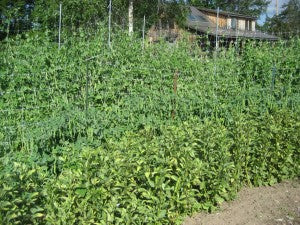In early March, the buzz among gardeners is always peas. Since they love the moderate temperatures of spring, getting peas planted as soon as the soil can be worked is best. If planted at the right time, while there is plenty of cool weather, your pea crop will reward you greatly with crisp and sweet pods that are an unmatched addition to spring cuisine.
About Peas
Peas generally succumb to downy mildew when the majority of the first set of peas have ripened. Make sure they don't succumb to downey mildew too early by trellising them, which encourages good air flow. Avoid handling and harvesting when the plants are wet. Downey mildew spreads through water and moisture and you can help keep it at bay by encouraging it to stay put if you have it.
Some varieties grow quite a bit taller than others, requiring a taller trellis, such as Sugar Snap, whereas the shorter varieties need less to no trellising such as Sugar Daddy, Green Arrow and Laxton's Progress.
If you have space for a trellis, taller varieties reward you with easy picking and higher yields. Shorter plants are good for smaller spaces, and their size makes them easier to manage over the taller varieties.
Harvesting Peas
Just like all things, peas have a peak harvest period. The harvest window for peak ripeness is short, so pick peas often. Use the following harvest information as a guide, but observe the appearance of your peas and taste them as you pick to make sure you are picking them to your personal preference.
Snap Peas
Snap peas sweeten as they plump, so plump peas are sweeter than skinny peas. However, wait too long, and your peas can become starchy and bitter.
 The snap pea on the far left is too small, and thus, not as sweet. The two peas on the far right are too mature, have started to turn whitish, and are bitter. The peas in the middle are just right!
The snap pea on the far left is too small, and thus, not as sweet. The two peas on the far right are too mature, have started to turn whitish, and are bitter. The peas in the middle are just right!Shelling Peas
Shelling peas are sweetest when they are young, but if you pick them too young they are quite small and you won't get much for the effort of picking and shelling them. Pick peas when they have started to fill out the pod and you can see the outline of individual peas. like Snap peas, if you let the peas get too big, they become starchy, hard and bitter. The shelling peas in the middle of each photo below are at peak sweetness and size.
Snow Peas
Quite the opposite of snap and shelling peas, snow peas should not be plump! Let the snow peas enlarge, but pick them before the peas in the pods begin to plump.
How to Pick
Picking peas is speediest with two hands--one hand to hold the vine, the other the pull the pea off. To pick hands-free, simply tie a bag or small bucket around your waist and empty it as it fills up.
Post harvest
Peas last longer and retain their sweetness if they are cooled immediately after picking. A cold water bath is most effective.
Snap peas can be blanched and frozen, but lose their crunch.They are best eaten fresh--raw or cooked lightly.
Shelling peas should be shelled asap and eaten or preserved for the sweetest results. Fresh peas only need to be cooked for about 2 minutes. To freeze shelled peas, steam them for 1 minute and then blanch them in ice cold water, then freeze, or simply place freshly shelled peas in a freezer bag directly in the freezer.









